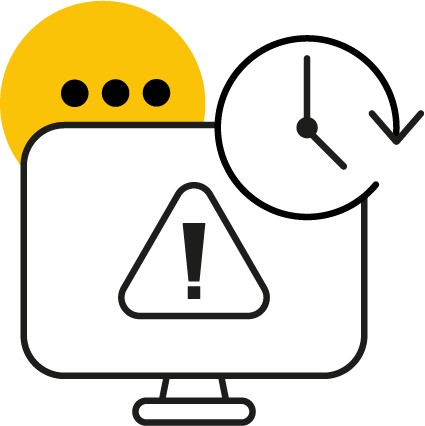Last updated on: March 28, 2023
Post the pandemic, managed service providers (MSPs) have adopted a business model in which the majority of the services they offer are delivered remotely, but they do still have to physically deploy technicians throughout their client locations for certain tasks. This is the reason why the demand for a proper field service management system is increasing among MSPs. The global field service management market was valued at $3.12 billion in 2018 and is now expected to grow to $10.81 billion by 2026.
What is field service management?
Field service management (FSM) is a method of organizing field service operations using a mobile workforce; in simpler words, it is all about managing the optimum availability of on-site technicians and staff. This process is typically undertaken by companies that need to manage the installation, service, or repair of systems or equipment.
FSM activities usually include:

Scheduling service orders

Dispatching agents to the field

Tracking agents' whereabouts

Tracking the status of jobs
The right FSM software simplifies field operations by automating these activities and enables mobile access.
A robust FSM system is essential to ensure that equipment is repaired or serviced so it continues to work as planned. Customer satisfaction is critical for contract renewal and increased customer spending, and customers rely on IT asset availability to keep their operations running properly. With the correct FSM system in place, all of these actions can be carried out and continuously monitored.
Field service management for managed service providers

Businesses worldwide are rapidly moving towards having MSPs manage their IT services and assets. And for organizations hiring an MSP, there’s a strong case for going with an MSP that has an FSM system in place. Organizations that deploy an FSM system have seen an increase in jobs completed per day as high as 47%, so it's only natural to see the growing popularity of FSM.
Aside from efficiency gains, there are other reasons an MSP may decide to implement an FSM system: the need for simplification of field-staff scheduling, competition in the MSP market to provide superior IT services, and movement in demand from the purchase of isolated maintenance and repair services to the procurement of long-term repair and maintenance contracts in the context of asset management.
For most businesses, FSM is very profitable as it allows them to:
- Concentrate resources and investments on core competencies.
- Focus on activities of strategic importance.
- Minimize the economic risk associated with uncertain failure rates of machines.
As a result, outsourcing maintenance and repair has become a valid alternative to self-provisioning for many companies, which in turn has fueled the need for a solid FSM system among MSPs.
Moreover, MSPs not only provide remote services and on-site repair and maintenance but sometimes go as far as to set up a small service provider program on customers' sites. For instance, Apple offers the Apple Authorized Service Provider Program, where it provides in-warranty and out-of-warranty repair service at the customer's location in the form of a camp office on the customer's site. With a proper FSM system in place, MSPs can ensure they have sufficient staffing and efficient operations in such camp offices in multiple locations.
Field service management challenges

The bigger the workload, the harder it is to manage, and MSPs are forced to discover more efficient ways to manage their customers’ growing organizations. Enter an FSM system.
This type of solution can help MSPs deal with the challenges that field services bring. Some of the crucial challenges in providing field services are:
Managing customer expectations
Matching or surpassing customers’ expectations is never easy. Poor management of field staff can lead to difficulty managing customer expectations. A good FSM system—coupled with a well-planned implementation of the tool—will minimize the amount of unsatisfied customers while maintaining service levels independent of upgrades, updates, or personnel movement.
Improving service delivery
Customers want services delivered on time and in a convenient location. Offering such services in the field creates additional complications, such as traffic, unfamiliar settings for technicians, and tasks lasting longer than expected. However, an FSM system may compensate for some of these bottlenecks and improve the consumer and employee experience.
Managing real-time communication
Given the multiplicity of information delivery options (text, email, website, or applications), it can be challenging to interact swiftly and easily with employees and customers.
FSM can equip all technicians with a common communication channel and all the information they need regarding customers, tasks, and so on.
Monitoring real-time resource location
The hassle of allocating jobs to field technicians intensifies when their locations are not visible in real time. A good FSM system helps MSPs monitor and identify resources in the field in real time.
Prioritizing safety and security
As a responsible MSP, your first priority should always be employee safety. Remote staff and field technicians face unfamiliar, uncontrolled environments. To reduce unnecessary risks, FSM can assist the workforce in identifying security threats and communicating with management or customers.
Benefits of field service management
An FSM system helps reduce operating costs, streamline field-staff assignment, and improve the issue resolution process significantly. Also, FSM help MSPs:


Improve first-visit resolutions and reduce mean time to repair
Assign the correct technician to the job and provide them with relevant information in a timely manner on a single console.

Streamline scheduling of staff
Mitigate issues, improve customer service, and cut down on wasted time with a transparent, dynamic approach to staff scheduling.

Support field staff
Provide technicians with remote support and mobile capabilities that will aid them in remaining safe, staying compliant.

Minimize field service expenditure
Cut costs by controlling travel expenses and monitoring other tools or software with the FSM system. Route optimization and dynamic scheduling help significantly reduce driving distance and fuel expenses.

Provide minimal downtime
Identify necessary repairs earlier in the asset life cycle to enable always-on operations, superior efficiency, and less downtime.

Ensure greater customer satisfaction
Determine if technicians are upholding customer expectations and addressing issues or unexpected delays as soon as possible.
Field service management best practices

MSPs’ field service provisioning used to have a terrible reputation among customers, and it was no secret why. Field service tragedies are aplenty, such as a technician arriving at the tail end of a three-hour appointment slot, unable to fix the issue.
But those days are gone! Your customers expect a much better experience now. Here are a few hand-picked best practices to help you manage field services expertly.
Schedule services at the appropriate time and place
If your daily workload comprises jobs in several locations, it's vital to be able to efficiently plan where and when to send your field technicians on a daily, weekly, and monthly basis. FSM software with scheduling capabilities can assist in the optimal allocation of work and manpower. It also allows you to respond to job assignments more quickly by eliminating phone calls from the office to the field. Are your field staff notified when and where they will be allocated an assignment? Look for FSM software that includes mobile app alerts to keep field staff up-to-date on schedule changes.
It should also allow them to clock in and out of each task from their device, allowing you to track the billable hours for each job precisely.
Track job costs
Make sure you appropriately track other parts of a job besides job costs, such as non-billable hours and assets. All of these factors influence the entire cost of the job, so it's critical to understand how everything fits together.
It's easier to prepare professional quotes for your customers and pay your field technicians fairly when you have a clear overview of job costs. Your FSM system should enable you to accept online quotes and convert them to a single or recurring job right away so you can get to work faster instead of waiting on approvals.
Monitor job progress
It is critical to maintain great communication on job status, regardless of how each member of your staff is engaging at work, e.g., their work hours or preferred communication channel. Better staff communication allows you to provide superior customer service while also ensuring everyone's accountability.
An FSM solution that automates workflows like sending text messages and emails to field staff via the software console helps monitor a job's progress. Additionally, your field workers should be able to enter job information and updates directly from the job site, ensuring that you always have a real-time picture of the time required to complete the job.
Identify and document problems
You must be proactive in identifying training shortages, operational inefficiencies, and service delivery bottlenecks in order to stand out. By staying on top of these issues, your FSM will be more successful and efficient throughout each customer engagement.
Management requires real-time information from their service teams in order to spot problems. Participate in talks with field service teams and seek honest input on operations and processes on a regular basis. Technicians who work closest to the customer frequently have the most insightful information.
Make sure you document the suggestions and feedback so you can readily share them with others in the chain, making the process of implementing changes go more smoothly.
Enable self-service for customers
A self-service portal centralizes real-time job details so customers can utilize the portal to make changes such as canceling or rescheduling appointments. This decreases call volume, wait periods, and appointment mix-ups.
Integrate FSM with existing systems
While isolated software can support business operations on their own, the true benefits come when numerous systems can communicate with one another. You can automate routine activities and streamline your technicians' workflows by integrating your FSM software with other platforms, such as your IT service desk software.
It costs time and frustrates technicians when they have to jump between different applications to gather all the information they need for a job. Your FSM software should give technicians the ability to check the history of a work order and debate it with appropriate peers, as well as read files and exchange images and videos of what they're seeing without leaving the app.
Important field service management KPIs and metrics

As an MSP, you know how essential it is to track KPIs, as each metric gives you important insights. Practically, you need to choose what to monitor and why. But how do you identify the metrics that matter most? What areas should be monitored to improve your FSM?
The following are the most essential KPIs and metrics to track:
Average number of work orders closed per day
Completed work is the yardstick by which field technicians are judged on a daily basis. It displays how many jobs a technician can do per day, even if the timetable is changed, and it indicates technicians' ability to handle ad hoc schedule modifications.
Percent of issues fixed on first visit
Measuring the first-visit success rate allows a company to increase its service business's productivity and profitability while also increasing customer loyalty. With continuous improvement of this KPI, the amount of time and resources spent on resolving a single issue can be reduced.
Mean time to complete, or average resolution time
If your organization can reduce the average time it takes to resolve an issue from the time it is reported to the time it is resolved, it will be able to finish more orders each day. To support this KPI, think about all the areas where processes could be sped up. The best path to each customer's location, as well as effective exchange of critical information between dispatchers and technicians, are among them.
Rescheduling ratio
The number of rescheduled jobs divided by all tasks indicates how much reactive work is required, as well as possible financial losses due to lost working hours or lost customers because of these changes.
Percent of field service visits performed within SLAs
This represents the percent of field service visits done within the desired response time.
Unexpected events will always occur, so obtaining 100% is impossible, but the higher the number, the better your field tech's performance. However, the exact optimal percentage depends on the industry and how field staff are managed.
Time spent traveling
Another measure to consider for dispatchers and schedulers is the time it takes workers to get to a customer site. If a field tech's travel time is high or increasing, it could suggest that technicians are being dispatched to jobs that are too far apart, that there are too few technicians with a particular specialty, or that too many last-minute jobs are being added to the schedule.
With this information, you can look at possible solutions, such as providing the best route for field workers on a mobile app, training more workers to provide a specific service to reduce specialized workers' travel, or finding a better approach to handling rush jobs.
Customer satisfaction
This is one of the most important KPIs to track in FSM since satisfied customers become loyal customers and help you forecast future revenue.
Customer retention
Existing customers are more valuable than new customers, and the revenue generated by loyal customers can help an organization remain profitable. New customer acquisition is generally a costly process that demands a significant amount of time and effort.
A retained customer, on the other hand, is mostly a happy customer. They'll provide you with the most effective and low-cost marketing available: word-of-mouth promotion. When your present customers vouch for you, you don’t have to put in as much effort to convert the new consumers that come through this route. That is why it is critical to track and improve this metric over time.
The future of field service management

Providing quality FSM is a top goal for many MSP organizations. MSPs want to deliver continual innovation and increased efficiency across their whole organization, so they will stay on top of FSM trends.
Check out some prominent trends that are in store in 2022:
Artificial intelligence and automation in FSM
As technology advances, AI will improve technicians' skills and minimize their training requirements. It will also help enhance the capacity to analyze massive amounts of fresh and historical data. AI-informed automated schedule optimization will aid dispatchers in resolving issues and will increase field resource productivity and effectiveness.
FSM in the cloud
The hybrid cloud will enable unified and endlessly expandable operations interfaces that connect knowledge and information throughout an organization, its partners, and its customers.
FSM and the Internet of Things
Predictive maintenance based on data from IoT devices and augmented-reality-powered service provisioning will reduce the amount of equipment and asset maintenance. According to reports, 60% of companies with an FSM function are looking to introduce technologies such as IoT to stay future-ready.
Conclusion

Post pandemic, the need for FSM has only increased. Seventy-nine percent of decision-makers at organizations with field services say they have invested in new service technology due to the pandemic. As an MSP, your customers expect you to have the latest and best tech in the business. Having a robust FSM system integrated with or as part of your IT service desk should be on the top of your to-do list if you don't already have one. A good FSM system can help minimize unproductive practices and free up administrative employees to focus on other important responsibilities, enhancing your organization’s bottom line, reining in spending, and getting the most value from this new world of work.
FAQs

What is field service management?
Field service management (FSM) is a practice that is followed to ensure effective planning, scheduling, and execution of field service activities. It involves the efficient use of resources, such as personnel, technology, and materials, to meet clients' service deadlines and standards. FSM also involves the coordination of on-field technicians, service delivery managers, and other stakeholders to ensure that clients receive high-quality services on time. FSM enables MSPs to reduce costs, manage resource availability, increase efficiency, and improve client satisfaction.
Who uses field service management software?
MSPs are increasingly leveraging FSM software to better manage their on-field client service operations. FSM software helps MSPs accurately track technician performance in the field; schedule and dispatch on-field technicians efficiently; and provide clients with timely, accurate updates on the status of their tickets. By using FSM software, MSPs can improve client satisfaction and boost their overall field service efficiency.
What does field service management do?
FSM is an essential aspect of MSP operations. It involves the accurate, timely scheduling of service appointments and the tracking of technicians' movements to ensure client satisfaction. The goal of FSM is to minimize clients' wait times, improve technicians' efficiency, and reduce manual costs associated with client services. By using the latest technologies, like mobile devices, location tracking, and client databases, MSPs can ensure that their field service operations are running smoothly.
ServiceDesk Plus MSP Evaluation Guide
Comprehensive list of must-have features that can be used as a benchmark for your IT service desk.



